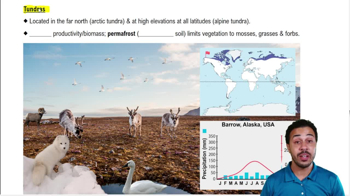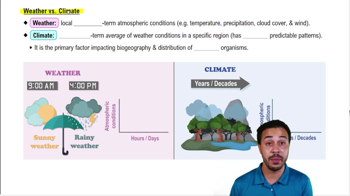Here are the essential concepts you must grasp in order to answer the question correctly.
Tundra Biome Characteristics
The tundra biome is characterized by its cold temperatures, short growing seasons, and limited vegetation. It typically features permafrost, a layer of permanently frozen soil, which restricts root growth and affects the types of plants that can thrive. Understanding these characteristics is essential for identifying the conditions under which tundra ecosystems exist.
Recommended video:
Geographical Distribution of Tundra
Tundra regions are primarily located near the poles, particularly in the Arctic and Antarctic areas, as well as at high altitudes in mountainous regions. This geographical distribution is influenced by climate factors such as temperature and precipitation, which create the unique environmental conditions necessary for tundra ecosystems.
Recommended video:
Geographic Impact on Communities
Climate and Altitude Effects
Both climate and altitude significantly impact the presence of tundra. Low average temperatures and short growing seasons are typical of tundra climates, while high altitudes can also create similar conditions. Recognizing how these factors interact helps in understanding why tundra can be found in various locations, including polar regions and high mountain ranges.
Recommended video:




